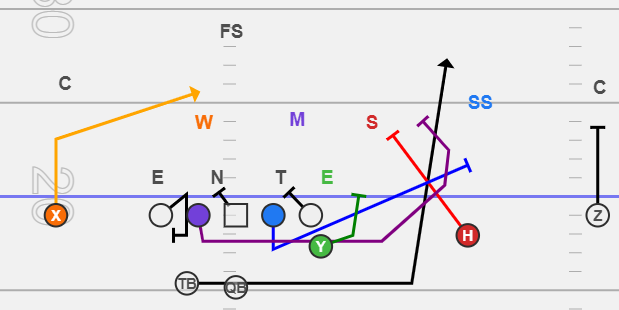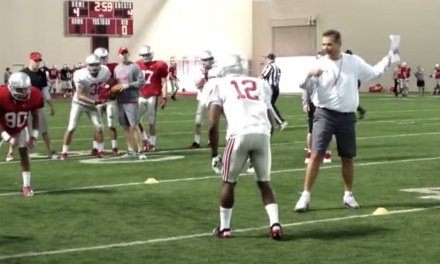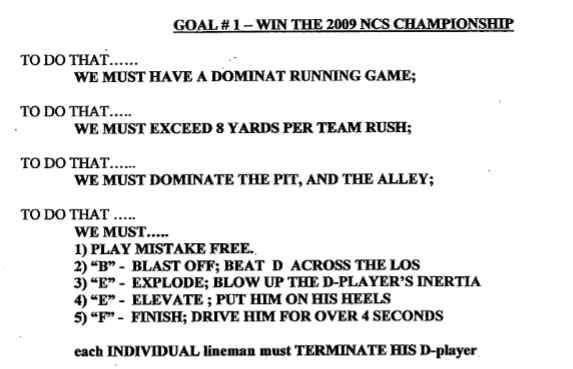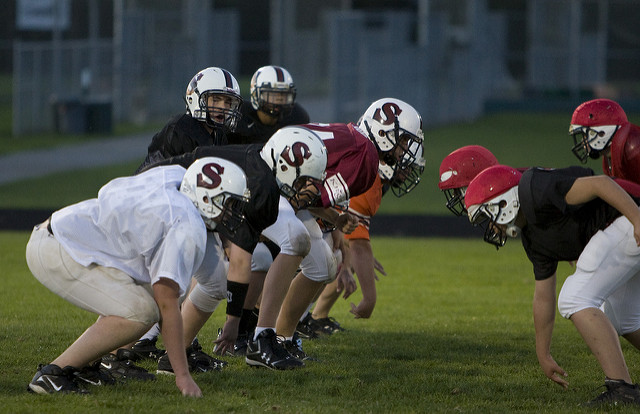In preparation for our 2019 season, Buck Sweep was the one key play we found that would help us best with the type of personnel changes we knew we had to make to move forward offensively.
That year our Hall of Fame head coach of 21 years retired and our offensive coordinator became the head coach and asked me to take over as coordinator.
We had been scoring boatloads of points with 10 personnel zone-read schemes for the previous six seasons due to the dynamic quarterbacks we were blessed to have.
But after 2018, we were going to be playing a pro-style QB, although great for our passing game, forced us to dramatically adjust our rushing attack.
Knowing we were going to need an H-back (which we call our Y) and an RPO package to run the ball, we began looking at all of the options we could consider using.
Power was the first play we agreed upon and G-H Counter was the second.
I’ve never been a big fan of inside zone, even with an 11 personnel kick or slice, so after Googling and YouTubing a few things to see what other teams were doing to go along with power, I ran into a Gus Malzahn video teaching the buck sweep.
From that point forward, I fell in love with the possibilities of the play, and our offensive line coach and I started digging into it.
Learn More about the Malzahn Offense and his Buck Sweep Here:
Pros:
As a team that wanted to run Power, we needed something to protect it.
We assumed counter would be it, but teams began lining up in a 4-4 to take away both Power and Counter, and it forced us into having to stay in 12 personnel to get everyone blocked.
The more we looked at Buck, the more we realized that it was Buck, and not Counter, that was going to protect Power.
Being able to use the slot receiver as the main blocker on the play, something you cannot do with Power or Counter, made it great for us because it fits into what we already did and allowed us to keep more playmakers on the field.
We also found that it stopped teams from blitzing our A gaps as frequently because the defense needs resilient linebackers to track down this play through the mess that occurs with so many players pulling and cracking.
Comparing between Power, Counter and Buck we have had the majority of explosive plays running Buck Sweep.
Cons:
There are very few cons to running Buck Sweep, but there are a lot of details to the play.
Because we wanted to be in base 11 personnel all the time and not be forced into pro-style or wing-t sets, it needed to be adjusted based upon the front we are facing, especially the difference between 40 Over and 40 Under.
It also needed to be taught in-depth to the WRs, since they would need to crack the play side LB with our most inside WR; and depending upon the formation and direction we ran it, that could be any of the three of them.
Once we add in the RPO, it becomes a play that all 11 need to understand very well, and therefore, we needed to create drills for it and practice it more than any other run play in our system.
Personnel Decisions
Personnel was never a concern in terms of running Buck, because we knew that other teams in our area that run the Wing-T extremely well, have players similar to ours.
So our next step was to determine how we were going to adjust our scheme due to the differences in how college and high school teams line up to the attached 3×1 formation.
One of the differences in the college game is that you get a lot of 2-high safeties, even in 11 personnel.
In high school, we do not have that. Versus a 40 front, we will get the same base 4-2 look, but with a Sam LB, sometimes the team’s best player, lined up over the top of our TE.
This created an issue for us, because now, instead of having six on six, we knew there would be a seventh defender in the box to try to stop us usually right where we wanted to run the buck sweep.
The first problem to solve was if it was better to add an RPO to handle that 7th defender, or just give it and hope that Will LB would not be able to fight through the mess to get there. We went with the RPO and moved forward.
Buck Sweep Blocking Rules (40 Over Front)
The blocking rules (Figure 1) we found very easy to teach because the kids already knew how to block Power and Counter. The techniques are very similar, so the players are doing things they do on other plays.
Just like Power, the center blocks back on the first down lineman, the backside tackle seals & wheels, and the play side tackle blocks down on a B gap player, or climbs to next level if nobody shows.
On the perimeter, our TE reaches the 5 Technique and our slot receiver cracks the first linebacker that shows, which is usually the Sam.
The players that love this play the most are the guards. The play side guard pulls and kicks out the first player that shows, which will usually be the defender lined up over your slot receiver.
The backside guard also pulls, and on paper is supposed to block the Mike, but amongst the chaos of the play, if he sees the opposite color jersey, he blocks it.
This is the block that makes the play break.
Lastly, if they blitz, he becomes a guard on a free safety.
Buck Sweep Adjustments vs 40 Under Front
Figure 2: 3×1 Buck Sweep vs. 40 Under
While we were still working on the blocking scheme versus a 40, we ran into our second problem – the inability to block the 1 Technique in an Under front (not having an inline TE allows a 40 team to run both a 4-Man Over or Under front).
We came to the conclusion that we could lock the play side guard onto the 1 Technique versus all Under fronts (Figure 2) and the problem was solved.
But then another issue came up because when we locked that play side guard, the backside guard needed to know that he is now kicking out the alley player, as opposed to leading up on the Most Dangerous Defender, which as mentioned above, usually becomes the Mike LB.
We practiced it and were OK, because that backside guard was still blocking the MDD, even if it was a strong safety, so the teaching was minimal and easily understood to our line.
However, this is not optimal, because not having both guards pulling does not make the play nearly as effective.
That being said, the entire first season we went with it and it was still successful enough for us to have an efficient play. But the next season, during some games, we decided to try pulling both guards, regardless of the front.
We figured if the DT can protect that A gap, and then sprint down the LOS and catch us, we would call it a learning experience and stop running it.
Fortunately for us, no matter how good the team was, they never were able to use their 1 Technique in that fashion, which I believe was due to us doing so many different things to him throughout the game with different reads and wham schemes that forced him to sit and play honestly.
Buck Sweep vs Odd Fronts
Another issue we ran into is adjusting the scheme for odd fronts, especially vs. a 50 Angle.
It creates an issue because the attached 3×1 to the field forces them to slant to the field, and puts the defense in an optimal position to defend Buck by now having two defenders outside of our down-blocking Play Side Offensive Tackle.
This forces our Y to have to reach both of them, which obviously does not work.
Our Adjustment (Figure 3) is that we would have everybody block as if it were outside zone, but allow both guards to still pull to make it Buck.
We run outside zone enough that it was an easy technical and schematic adjustment for us, so we went with it.
My original thought was that the outside zone motion would make the play stretch wide, but what ended up happening is the seal blocks by the wing and slot receiver create a seam that is not much different from what we had versus a 40.
Buck Sweep vs 3-3 Stack
Finally, one of our biggest rivals runs a 3-3 Stack, which on paper never seems to be an issue to run against, but always causes us problems during games.
What we found is that we already had the basic ideas needed to block it with a mixture of the 40 and 50 adjustments.
Here you can see we will pull both guards (Figure 4).
The rules are the same Buck rules used versus a 40 and we had the center reach the nose. Surprisingly, that was it!!
Conclusion
Buck Sweep has been a great play for us and I would suggest discussing it with your staff if you are looking for something to compliment your Power Run Game. We were able to run this play multiple times and multiple ways per game as we grew into it and the more you run it, the more you will see the things you can add to it.
You can also run it out of multiple formations and personnel packages without too much trouble.
We found we could read defenders if we have a running quarterback and utilize an RPO if that becomes something we improve upon. The kids love running it because the tackles do what they are comfortable doing, and the guards get to run.
It also helps our Y tremendously because the hardest thing he has to do is kick out the Defensive End on Power, but now that we run Buck, it has made defensive ends much less aggressive.
This makes Buck Sweep a great answer to all defenses.
Article Written by Coach Aaron Szabo
Offensive Coordinator
Kings High School
Kings Mills, OH (Cincinnati Area)






Sorry, but you have no business calling this play a buck sweep. It’s not a buck sweep unless there’s a buck to go with it, and a buck fake when you run sweep. A buck is a run into the line. These days the commonest buck sweep in buck sweep series is a trap. So if your QB were faking a guard trap, then you’d have a buck sweep series and the sweep would be a buck sweep. The QB’s action back side here is not the same thing.
In my version for the trap, the purple guard would be trapping while the blue guard would be influence pulling to make it look like the sweep.
What did you think “BUCK sweep” meant that distinguished it from other sweeps?
I think Coach Szabo is simply calling it that because it is an adjusted version of Buck Sweep that Malzahn runs. Why Malzahn calls it that and not something else is up to him. I’m comfortable calling it a Buck Sweep but I do understand that it is NOT the Wing T version of the play.
Hi Robert, thank you for commenting. To run the action you’re looking for out of an 11 personnel set, you can run what people call HORN. Put the TB on the playside, and have him come get the ball before getting back on his sweep path. This gives you the ILB hold that the Buck Trap gave you, while also allowing for the Sweep within the same play design.
Coach, good read. I was curious about a couple of things regarding the Y/H Back. What is his alignment? What is his footwork and progression? From my understanding Malzahn has him in the sniffer position and it kind of seems like he is an extra guard almost.
Coach Theobold, thank you for reading the article!
I agree that the biggest question is how to teach the hipped player to block the EMOL. FIrst of all, you need to stay square. We definitely want to reach that EMOL, but if you turn sideways, the EMOL just runs right up field and either collides with one of your guards of tackles the running back because he’s unblocked.
We don’t line up like Coach Malzahn has drawn it, because we can’t reach the guy, we can only kick him out. We will move out ever so slightly to not create a “tell”, take a bucket step with our outside foot, and work to get our inside hand and foot on their outside chest and outside leg. Once we get there, we can continue to drive, and something that shocked me, is we are almost always able to reach him. I think this is because we also run Power so much, that the EMOL feels like he has to take that way first. Anyway, our alignment of the hipped player is splitting the crotch of the offensive tackle with our inside foot. Then, depending upon the player and the play you run best, you can determine very early into practice or the season, what kind of adjustment you need to make to his alignment to make your play more successful.
You definitely have to run Power to run Buck. If not, like I said, they’ll stay outside. But once you see them staying outside, even your worst player can kick them out on Power, because they are giving it to you. If you have enough coaches (or have HUDL sideline which is what I use), I would suggest having one of them watch the the EMOLs are playing it. What they are doing will tell you which play, Power or Buck, to run next. Plus, Power is better is they’re running an Under Front, and Buck is better if they’re running an Over Front. So having those two together, enables you to go into games vs. teams that run multiple fronts, and know you are capable of running either one. And sometimes we will run one much more than the other, if that’s what they are giving us.
Thanks again! Keep the questions coming if I did not answer it well enough.
Aaron
Thanks Coach, that is great and very helpful.
I have a few more questions about the offense, if you would be willing to discuss, please send me an email at wtheobold@gmail.com.